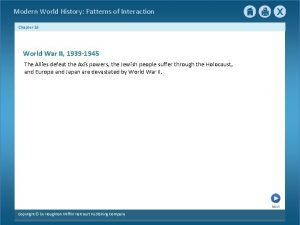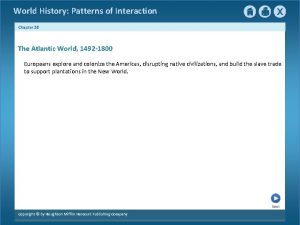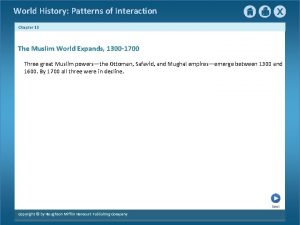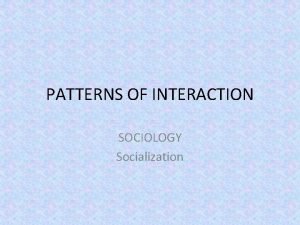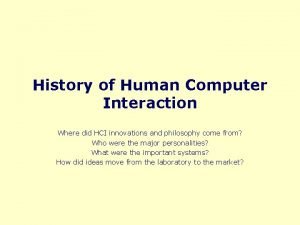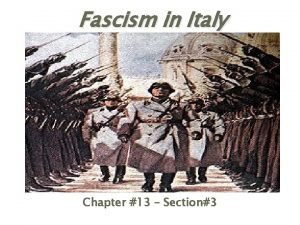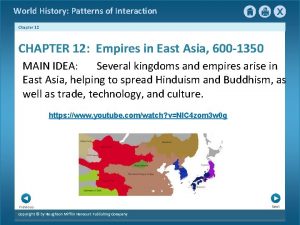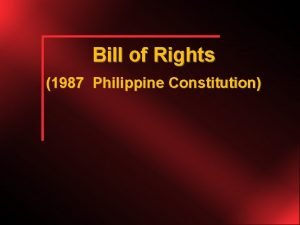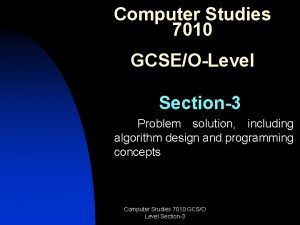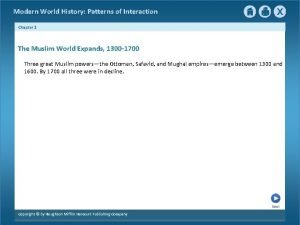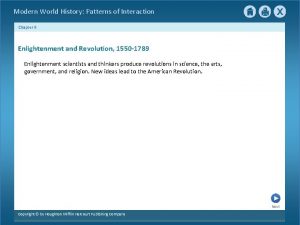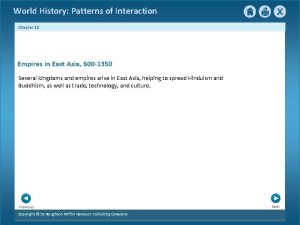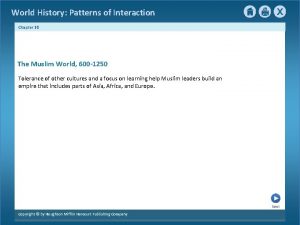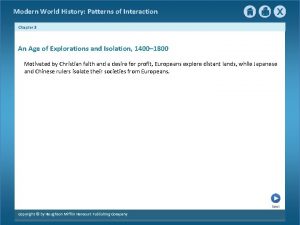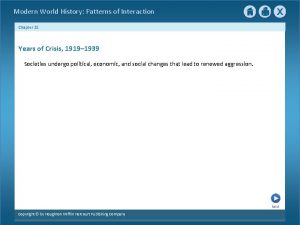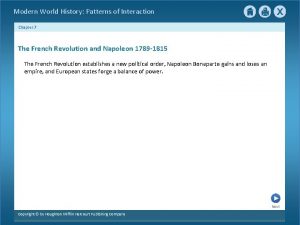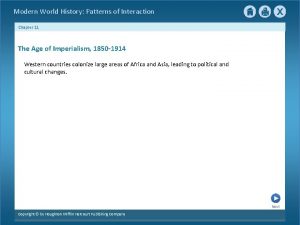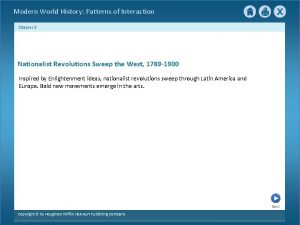World History Patterns of Interaction Chapter 17 Section3

















- Slides: 17

World History: Patterns of Interaction Chapter 17 Section-3 Luther Leads the Reformation Martin Luther’s protest over abuses in the Catholic Church lead to the founding of Protestant churches. Previous Copyright © by Houghton Mifflin Harcourt Publishing Company Next

World History: Patterns of Interaction Chapter 17 Section-3 Luther Leads the Reformation Causes of the Reformation Church Authority Challenged • • Secularism, individualism of Renaissance challenge Church authority Rulers challenge Church’s power Printing press spreads secular ideas Northern merchants resent paying church taxes Criticisms of the Catholic Church • • Corrupt leaders, extravagant popes Poorly educated priests Previous Copyright © by Houghton Mifflin Harcourt Publishing Company Continued… Next

World History: Patterns of Interaction Chapter 17 Causes of the Reformation {continued} Early Calls for Reform • • • John Wycliffe and Jan Hus stress Bible’s authority over clergy’s Desiderius Erasmus and Thomas More are vocal critics of the Church Reading religious works, Europeans form own opinions about Church Previous Copyright © by Houghton Mifflin Harcourt Publishing Company Next

World History: Patterns of Interaction Chapter 17 Luther Challenges the Church The 95 Theses • • • Martin Luther protests Friar Johann Tetzel’s selling of indulgences Indulgence —a pardon releasing a person from penalty for a sin In 1517 Luther posts his 95 Theses attacking “pardon-merchants” Luther’s theses circulate throughout Germany Luther launches the Reformation—a movement for religious reform Reformation rejects pope’s authority Previous Copyright © by Houghton Mifflin Harcourt Publishing Company Continued… Next

World History: Patterns of Interaction Chapter 17 3 Luther Challenges the Church {continued} Luther’s Teachings • • • People can win salvation by good works and faith Christian teachings must be based on the Bible, not the pope All people with faith are equal, can interpret Bible without priests Previous Copyright © by Houghton Mifflin Harcourt Publishing Company Next

World History: Patterns of Interaction Chapter 17 The Response to Luther The Pope’s Threat • Pope Leo X issues decree threatening to excommunicate Luther (1520) • Luther’s rights of Church membership are taken away • Luther refuses to take back his statements and is excommunicated The Emperor’s Opposition • Charles V is Holy Roman Emperor • He issues Edict of Worms (1521), declaring Luther a heretic • Luther and followers begin a separate religious group—Lutherans Previous Copyright © by Houghton Mifflin Harcourt Publishing Company Continued… Next

World History: Patterns of Interaction Chapter 17 3 The Response to Luther {continued} The Peasants’ Revolt • • Inspired by Reformation, German peasants seek end to serfdom (1524) Princes crush revolt; about 100, 000 people die Germany at War • • • Some princes side with Luther, become known as Protestants Charles V fails to return rebellious princes to Catholic Church Peace of Augsburg (1555)—each prince can decide religion of his state Previous Copyright © by Houghton Mifflin Harcourt Publishing Company Next

World History: Patterns of Interaction Chapter 17 England Becomes Protestant Henry VIII Wants a Son • Henry has only daughter, needs male heir to rule England • Henry wants a divorce; Pope refuses to annul—set aside—his first marriage to Catherine of Aragon The Reformation Parliament • Parliament passes laws ending pope’s power in England • Henry remarries, becomes official head of England’s Church • Thomas More refuses to go against Catholic Church and is beheaded Previous Copyright © by Houghton Mifflin Harcourt Publishing Company Continued… Next

World History: Patterns of Interaction Chapter 17 England Becomes Protestant {continued} Consequences of Henry’s Changes • Henry has six wives and three children • Religious turmoil follows Henry’s death (1547) • Protestantism under King Edward, then Catholicism under Queen Mary Elizabeth Restores Protestantism • Henry’s second daughter, Queen Elizabeth I, forms Anglican Church • Anglican Church is acceptable to moderate Catholics and Protestants Previous Copyright © by Houghton Mifflin Harcourt Publishing Company Continued… Next

World History: Patterns of Interaction Chapter 17 England Becomes Protestant {continued} Elizabeth Faces Other Challenges • Some Protestants and Catholics oppose Elizabeth • Phillip II, Catholic King of Spain, threatens England • Elizabeth’s need for money brings conflict with Parliament Previous Copyright © by Houghton Mifflin Harcourt Publishing Company Next

World History: Patterns of Interaction Chapter 17 Section-4 The Reformation Continues As Protestant reformers divide over beliefs, the Catholic Church makes reforms. Previous Copyright © by Houghton Mifflin Harcourt Publishing Company Next

World History: Patterns of Interaction Chapter 17 Section-4 The Reformation Continues Calvin Continues the Reformation Religious Reform in Switzerland • Swiss priest Huldrych Zwingli calls for Church reforms (1520) • War breaks out between Catholics, Protestants; Zwingli killed (1531) Calvin Formalizes Protestant Ideas • John Calvin writes Institutes of the Christian Religion (1536): -we are sinful by nature and cannot earn salvation -God chooses who will be saved—predestination • Calvinism—religion based on Calvin’s teachings Previous Copyright © by Houghton Mifflin Harcourt Publishing Company Continued… Next

World History: Patterns of Interaction Chapter 17 Calvin Continues the Reformation {continued} Calvin Leads the Reformation in Switzerland • Calvin says ideal government is theocracy—rule by religious leaders • Geneva becomes a strict Protestant theocracy led by Calvinism Spreads • • John Knox brings Calvinism to Scotland, followers are Presbyterians Church governed by laymen called presbyters, or elders Calvin’s followers in France called Huguenots Catholics massacre Huguenots in Paris (1572) Previous Copyright © by Houghton Mifflin Harcourt Publishing Company Next

World History: Patterns of Interaction Chapter 17 Other Protestant Reformers The Anabaptists • Anabaptists believe in separation of church and state, oppose wars • Forerunners of Mennonites and Amish Woman’s Role in the Reformation • Marguerite of Navarre protected Calvin in France • Katrina Zell also protects reformers • Katherina von Bora, Luther’s wife, promotes equality in marriage Previous Copyright © by Houghton Mifflin Harcourt Publishing Company Next

World History: Patterns of Interaction Chapter 17 The Catholic Reformation A Counter Reformation • Catholic Reformation—seeks to reform Catholic Church from within Ignatius of Loyola • • Leading Catholic reformer His Spiritual Exercises (1522) calls for meditation, prayer, and study Pope creates Society of Jesus religious order, the Jesuits follow Ignatius, start schools, convert non-Christians Previous Copyright © by Houghton Mifflin Harcourt Publishing Company Continued… Next

World History: Patterns of Interaction Chapter 17 The Catholic Reformation {continued} Reforming Popes • Pope Paul III and Pope Paul IV lead reforms • Paul III calls Council of Trent to lay out reforms: -Church’s interpretation of Bible is final -Christians need faith and good works for salvation -Bible and Church traditions equally important -Indulgences are valid expressions of faith • Use Inquisition to seek out heresy • Paul IV issues Index of Forbidden Books (1559); books burned Previous Copyright © by Houghton Mifflin Harcourt Publishing Company Next

World History: Patterns of Interaction Chapter 17 The Legacy of the Reformation Religious and Social Effects of the Reformation • Catholic Church is unified; Protestant denominations grow • Catholics and Protestants create schools throughout Europe • Status of women does not improve Political Effects of the Reformation • Catholic Church’s power lessens, power of monarchs and states grow • Reformation’s questioning of beliefs brings intellectual ferment • Late 18 th century sees a new intellectual movement—the Enlightenment Previous Copyright © by Houghton Mifflin Harcourt Publishing Company Next
 World history patterns of interaction
World history patterns of interaction Chapter 20 section 3 world history
Chapter 20 section 3 world history The golden age chapter 18
The golden age chapter 18 World history patterns of interaction
World history patterns of interaction Ap world history chapter 25 africa and the atlantic world
Ap world history chapter 25 africa and the atlantic world Interaction patterns in groups
Interaction patterns in groups Mean girls sociology
Mean girls sociology Sector d group chapter 3
Sector d group chapter 3 Bad dangerous tour
Bad dangerous tour In traditional dating patterns dating behavior
In traditional dating patterns dating behavior Closed patterns and max-patterns
Closed patterns and max-patterns History of hci
History of hci Chapter 17 section 3 luther leads the reformation
Chapter 17 section 3 luther leads the reformation Chapter 32 assessment world history
Chapter 32 assessment world history Chapter 30 section 2 world history
Chapter 30 section 2 world history Chapter 15 section 2 world history
Chapter 15 section 2 world history Chapter 13 ap world history
Chapter 13 ap world history Chapter 15 section 3 fascism rises in europe
Chapter 15 section 3 fascism rises in europe
